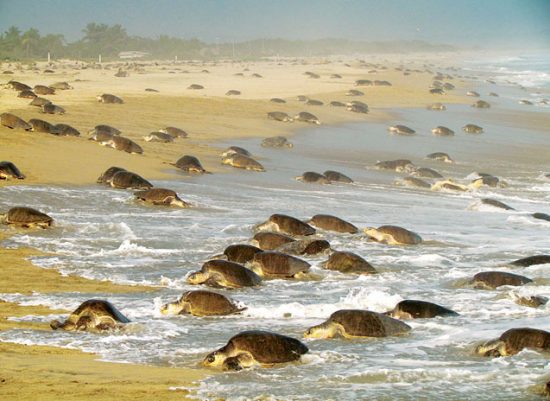PLAYA LA ESCOBILLA, Oaxaca — Nesting endangered marine turtles have arrived at La Escobilla beach on Mexico’s Pacific coast in their annual migration, a sign that life is about to burst forth from scorched grains of sand.
“We hope to receive some 150,000 nestings which means 15 million eggs. Of those, not all will make it,” said Erika Peralta, who is in charge of the Olive Ridley Sea Turtle Sanctuary Cooperative on La Escobilla beach in Oaxaca state.
Reuters reports that only 10 percent of the 15 million eggs are expected to hatch in 45 days, according to biologists.
Once they hatch, the tiny black baby reptiles will haul themselves to the sand’s surface and painstakingly crawl to the sea.
Small enough at birth to fit into a child’s palm, females will hit land again as adults in 25 to 30 years’ time, thanks to a genetic homing device that makes them return to the beach where they hatched so as to carry on the reproductive process. Males will never return.
The endangered Olive ridleys, whose numbers worldwide have plummeted in recent decades after mass exploitation, are one of the smallest sea turtles, weighing up to 100 pounds (45 km) and reaching some 2 feet (65 cm) in length as adults.
Their hatching is a natural spectacle and local families have taught their children to protect the marine turtles.
“I’m looking after them. So that they (poachers) don’t come and steal their eggs, kill them. So that dogs, black vultures don’t kill them,” said Benito Cortes, a young boy.
The turtles come to nest along 15 kilometers (9.3 miles) of protected coastline.
Volunteers at the Sanctuary Cooperative on La Escobilla beach, in the town of Santa Maria Tonameca, battle for turtle conservation in the Pacific Ocean. Populations of several species of Gulf Coast turtles have collapsed after being hunted to the brink of extinction.
“In arrival beaches it’s common the percentages of survival are low due to the number of eggs being laid,” Peralta said.
For several years, she and dozens of volunteers have worked to protect the beach and the region’s ecotourism.
This beach sees between seven and eight nesting arrivals per year of marine turtles to nest. This year’s third season is the largest.
There are 12 beaches where Olive ridley turtles nest around the world, according to Mexico’s National Commission of Natural Protected Areas (CONANP).
According to the World Wildlife Fund (WWF), marine turtles have been around for over 100 million years. Natural predators have been around for thousands of years but it is the impact of humans which is affecting their numbers, either through hunting or entanglement in fishing nets
Source: reuters.com




